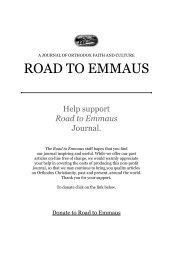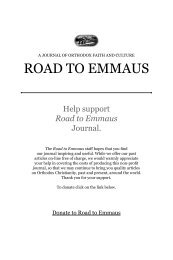RTE No 20 Interior - Road to Emmaus Journal
RTE No 20 Interior - Road to Emmaus Journal
RTE No 20 Interior - Road to Emmaus Journal
Create successful ePaper yourself
Turn your PDF publications into a flip-book with our unique Google optimized e-Paper software.
<strong>Road</strong> <strong>to</strong> <strong>Emmaus</strong> Vol. X, <strong>No</strong>. 1 (#36)and smoke from the explosives. The men worked in the dark with candleson their helmets. They were answerable <strong>to</strong> the mine’s steward and if theyarrived at work a minute late they were sent home. They worked chained. Achain was fastened around their upper leg, and they were suspended fromthis chain, which was attached <strong>to</strong> a rod hammered in<strong>to</strong> the slate face. Inother countries, these working conditions are considered penal conditions,for example, in the old salt mines in Siberia. In the winter, the slate minerswouldn’t see the light of day. They started work before dawn and finishedafter dark.Nevertheless, there was a sort of vibrant cultural life in those mining <strong>to</strong>wns,partly due <strong>to</strong> the fact that these miners didn’t want bright young men <strong>to</strong> have<strong>to</strong> work in the same conditions. They would save money, for example, andgather pennies and subscriptions <strong>to</strong> send bright youngsters <strong>to</strong> the university.Many young men from that time owe a lot <strong>to</strong> their mining families andfriends, who made sure that they didn’t have <strong>to</strong> go in<strong>to</strong> the mines. In fact,those miners paid <strong>to</strong> set up the University of Wales.In just such a way they built their nonconformist chapels, of which at onetime there were forty-two in our <strong>to</strong>wn which, at its height, had a populationof 12,000. Having all of these sectarian chapels was characteristic of Welshsociety at the time.That was the formative period for Blaenau Ffestiniog, but we have <strong>to</strong> realizethat because the <strong>to</strong>wn is located very high up in the mountains at theend of a valley, in the normal course of events, no one would have though<strong>to</strong>f building a <strong>to</strong>wn there. It came in<strong>to</strong> being only because of the slate miningindustry, and is built in the shape of an inverted horseshoe – so you can beon one side of the <strong>to</strong>wn and look across the valley <strong>to</strong> the other side.In addition <strong>to</strong> valuing culture, many people, of course, also valued theirreligious heritage, but as in most other places in <strong>No</strong>rth Wales, this was a veryCalvinistic form of Protestantism. In the South Wales valleys, where coalmining was the dominant industry, Calvinism didn’t dominate in the sameway. This is something we should return <strong>to</strong> when we analyze the logistics ofwhat Orthodox mission involves in a post-Calvinist society.rte: When did the slate mining s<strong>to</strong>p?fr. deiniol: It hasn’t s<strong>to</strong>pped; it continues, but on a much-reduced scale.People sometimes compare the <strong>No</strong>rth Wales slate-mining areas with thePho<strong>to</strong>: Blaenau Ffestiniog. Courtesy of Geraldine Fagan










